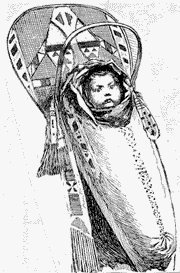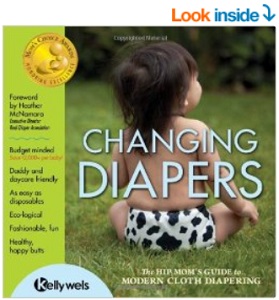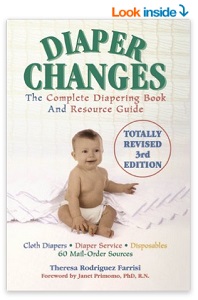
|
|||||
|---|---|---|---|---|---|

|
|||||
(Reprinted with permission from Diapers Unlimited, Cotton Diaper Service, Kalamazoo, MI)

First Nation mothers once collected the soft insides of milkweed to pack around their babies before strapping them into a papoose board. Eskimo moms gathered moss during the short summer months and placed it inside the animal skins in which they carried their babies.
Over the years, mothers have relied on a variety of methods to diaper their babies. From prairie plants to plastic-covered paper to all-natural cotton, busy moms have tried to balance what's best for their baby with what's convenient for them.
It's hard to believe, but in Elizabethan times, babies were treated to a fresh diaper every four days! Little sons and daughters of royalty were more fortunate - and changed once a day. The diapers themselves were squares of cloth held on with string tied around the baby's stomach.

When the pioneers pushed westward in covered wagons, mothers made all their children's diapers, carefully rolling and hand-stitching the edges. Wet diapers were seldom washed, just hung by the fireplace to dry.
The first all-cotton diapers were made in America. A 21 by 40-inch rectangle was folded and tucked and pinned. Mothers might buy six to seven dozen diapers to keep up with their baby.
Diaper services grew all over the country during World War II. Many mothers were working in defense plants making airplanes, tanks and submarines instead of washing diapers at home.
Back in the 1940's, fresh cotton diapers were delivered wrapped in blue paper. In the evening, the family gathered around the radio to listen to the news and Fibber McGee - and fold diapers.
During the Eisenhower era (1950's), there was another big change in the diaper. Mrs. Hellerman - owner of a diaper service in Milwaukee - went to the Kendall Company, which made Curity® brand diapers, with a new invention. It was a fold that put extra cotton layers in the centre of the diaper and made it about the right size for most babies. The fold was sewn shut, and the prefolded diaper was born. No more family folding parties!
A few years later, Kendall Company began making the prefolded diaper in a smaller size especially for diaper services. They fit newborns from a premie
to a baby 10 pounds.
In the 60's, use it and toss it
and heat and eat
sold a lot of new products. Plastic was pop
and mod
. Plastic-covered paper diapers were a big hit. As the years went on, reusable tab closures and gathered legs were added to the diapers.
One of the most recent technologies is the addition of acrylic acid polymer salts, a chemical that turns to gel when wet, to absorb moisture.

Changing Diapers - The Hip Mom's Guide to Modern Cloth Diapering |
Today, health experts and overflowing landfills have created new priorities for parents to consider. Like the pesticides whose problems are now believed to outweigh the benefits, the
convenience
of disposable diapers is getting another look.
Buried in a landfill, all the disposables disposed of
will be around for the next 500 years.
At its 1990 meeting, The American Public Health Association adopted a resolution on disposable single-use diapers. The resolution discusses landfills, risks to sanitation workers and groundwater, and the fact that many parents have simply not noticed the warnings on the package instructing them to empty and rinse the diaper in the toilet and separate the plastic.
APHA's Executive Director stated, APHA believes that the reliance on disposable diapers . . . poses potential and unwarranted health and environmental risks.
Environmental issues are one reason why hospitals are taking another look at all-natural cotton diapers. But what's really convincing hospitals to switch back to cotton is its softness, and the ability of accredited diaper services to surpass hospital standards of cleanliness.

Diaper Changes: The Complete Diapering Book and Resource Guide |
And today's diaper services offer convenience to parents too.
Clean cotton diapers are delivered to the home every week. At the same time, soiled diapers which have been placed in a special deodorizing hamper after use, are whisked away to be washed with environmentally friendly products, including a bacteriostat that helps prevent odour.
Most diaper services offer waterproof diaper covers which simply wrap over diapers and close with tabs, no pins needed. The convenience of diaper services has created a viable alternative to the disposable
.
Yes, we know the cost is at least two times that of washing your own diapers - but your time is really precious in those early weeks. Spend your time recovering, establishing a good milk supply... Enjoying and getting to know your new baby... This time passes so-o quickly and we don't want you to have to spend it washing diapers!
So do yourself a favour . . . without adding to our growing landfill and environmental problems.
This article compliments of Born to Love.
Send questions, comments, and suggestions to: catherine@borntolove.com
Born to Love articles are written by Catherine McDiarmid-Watt
Born to Love is a participant in the Amazon Services LLC Associates Program, an affiliate advertising program designed to provide a means for sites to earn advertising fees.
NOTE: All logos, company names, brands, images, trademarks and other intellectual property are the property of their respective owners.
Born to Love is a participant in the eBay Partner Network, an affiliate advertising program designed to provide a means for sites to earn advertising fees by advertising and linking to eBay.com.
Copyright © 1978 - BorntoLove.com - All Rights Reserved.
Last updated - April 5, 2024